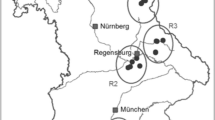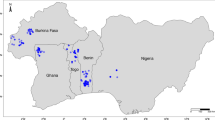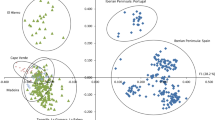Abstract
Agave potatorum is a wild endemic species of Mexico. Its stems are used for mescal production, which cancels sexual reproduction. Agaves extraction from forests decreases their reproductive success and demographic performance. We evaluated patterns of genetic diversity and structure of wild populations under and without extraction in order to identify effects of its use and actions required for conserving genetic variation. This study was conducted with seven SSR markers in 12 populations representing the entire distribution area of the species. Standard parameters of genetic diversity, differentiation, structure and genetic similarity of populations were calculated and analyzed. The populations studied showed intermediate to high genetic diversity (H e = 0.36–0.64), compared with other Agave species so far studied. The wild category was the most diverse (H T = 0.87), but without significant differences with respect to populations under extraction (H T = 0.72), and two germplasm banks sampled (H T = 0.69). High structure among populations (Φ PR = 0.38) and inbreeding levels (F IS = 0.26, F IT = 0.55) were identified; a 3 % of genetic diversity being distributed among management status where germplasm banks represent a genetic pool with incipient divergence from the other categories. Bayesian analysis indicated two genetic groups. Our study suggests slight effects of management on genetic diversity of A. potatorum, apparently related to alterations of reproductive biology and pollination patterns.




Similar content being viewed by others
References
Addison JA, Hart MW (2005) Spawning, copulation and inbreeding coefficients in marine invertebrates. Biol Lett 1:450–453
Aguirre-Dugua X, Eguiarte LE (2013) Genetic diversity, conservation and sustainable use of wild Agave cupreata and Agave potatorum extracted for mezcal production in Mexico. J Arid Environ 90:36–44
Alvarez-de Zayas A (1989) Distribución geográfica y posible origen de las Agavaceae. Rev Jard Bot Nac Univ Habana Cuba 10:25–35
Barraza-Morales AF, Sánchez-Teyer L, Robert M, Esqueda M, Gardea A (2006) Genetic variability in Agave angustifolia Haw. at the Sonoran Sierra, México, as determined by AFLP markers. Rev Fitotec Mex 29:1–8
Blancas J, Casas A, Rangel-Landa S, Moreno Calles A, Torres I, Pérez-Negrón E, Solís L, Delgado-Lemus A, Parra F, Arellanes Y, Caballero J, Cortés L, Lira R (2010) Plant Management in the Tehuacán-Cuicatlán Valley, Mexico. Econ Bot 64:287–302
Byers C, Maughan PJ, Clouse J, Stewart JR (2014) Microsatellite primers in Agave utahensis (Asparagaceae), a keystone species in the Mojave Desert and Colorado Plateau. Appl Plant Sci 2:1–3
Casas A, Caballero J, Mapes C, Zarate S (1997) Manejo de la vegetación, domesticación de plantas y origen de la agricultura en Mesoamérica. B Soc Bot Mex 61:31–47
Casas A, Caballero J, Valiente-Banuet A (1999) Use, Management and domestication of columnar cacti in southcentral Mexico: a historical perspective. J Ethnobiol 191:71–75
Casas A, Otero-Arnaiz A, Pérez-Negrón E, Valiente-Banuet A (2007) In situ management and domestication of plants in Mesoamerica. Ann Bot Lond 100:1101–1115
Colunga-GarcíaMarín P, Zizumbo-Villareal D (2007) Tequila and other Agave spirits from west-central Mexico: current germplasm diversity, conservation and origin. Biodivers Conserv 16:1653–1667
Colunga-GarcíaMarín P, Coello-Coello J, Eguiarte LE, Piñero D (1999) Isozymatic variation and phylogenetic relationships between henequén (Agave fourcroydes) and its wild ancestor A. angustifolia (Agavaceae). Am J Bot 86:115–123
Colunga-GarcíaMarín P, Zizumbo-Villareal D, Torres-Martínez J (2007) Tradiciones en el aprovechamiento de los Agaves mexicanos: una aportación a la protección legal y conservación de su diversidad biológica y cultural. In: Colunga-GarcíaMarín P, Larque Saavedra A, Eguiarte LE, Zizumbo-Villareal D (eds) En lo ancestral hay futuro: del tequila, los mezcales y otros agaves. Centro de investigación Científica de Yucatán A. C., pp 229–248
Dávila P, Arizmendi MC, Valiente-Banuet A, Villaseñor JL, Casas A, Lira R (2002) Biological diversity in the Tehuacán-Cuicatlán Valley, Mexico. Biodivers Conserv 11:421–442
Delgado-Lemus A, Casas A, Tellez O (2014a) Distribution, abundance and traditional management of Agave potatorum in the Tehuacán Valley, Mexico: bases for sustainable use of non-timber forest products. J Ethnobiol Ethnomed 10:63
Delgado-Lemus A, Torres I, Blancas J, Casas A (2014b) Vulnerability and risk management of Agave species in the Tehuacán Valley, México. J Ethnobiol Ethnomed 10:53
Earl DA, Vonholdt BM (2012) Structure Harvester: a website and program for visualizing STRUCTURE output and implementing the Evanno method. Conserv Genet Resour 4:359–361
Eguiarte LE, Souza V, Silva-Montellano A (2000) Evolución de la familia Agavaceae: Filogenia, Biología Reproductiva y Genética de poblaciones. Bol Soc Bot Mex 66:131–150
Eguiarte LE, Aguirre-Planter E, Aguirre X et al (2013) From isoenzymes to genomics: populations genetic and conservation of Agave in México. Bot Rev 79:483–506
Estrella-Ruíz JP (2008) Efecto de la explotación humana en la biología de la polinización de Agave salmiana y Agave potatorum en el Valle de Tehuacán-Cuicatlán. M.Sc. Dissertation, Universidad Nacional Autónoma de México, Distrito Federal, México
Evanno G, Regnaut S, Goudet J (2005) Detecting the number of clusters of individuals using the software STRUCTURE: a simulation study. Mol Ecol 14:2611–2620
Excoffier L, Lischer H (2010) Arlequin suite ver 3.5: a new series of programs to perform population genetics analyses under Linux and Windows. Mol Ecol Resour 10:564–567
Falush D, Stephens M, Pritchard JK (2003) Inference of population structure using multilocus genotype data: linked loci and correlated allele frequencies. Genetics 164:1567–1587
Felsenstein J (1985) Confidence limits on phylogenies; an approach using the bootstrap. Evolution 39:783–791
Figueredo JC, Nassar JM (2011) Population genetics of Agave cocui: evidence for low genetic diversity at the southern geographic limit of genus Agave. J Hered 102:306–314
García S (2014) Diversidad genética y efecto del cambio climático en la distribución de Quercus potosina (Fagaceae) en Sierra fría, Aguascalientes: un enfoque local para su conservación. B.Sc. Dissertation, Universidad de la Sierra de Juárez. Ixtlán de Juárez, Oaxaca. México
García-Mendoza A (2002) Distribution of Agave (Agavaceae) in Mexico. Cactus Succul J 74:177–186
García-Mendoza A (2010) Revisión taxonómica del complejo Agave potatorum Zucc. (Agavaceae): nuevos taxa y neotipificación. Acta Bot Mex 91:71–93
García-Mendoza A, Galván R (1995) Riqueza de las Familias Agavaceae y Nolinaceae en México. Bol Soc Bot Mex 56:7–24
Gentry HS (1982) Agaves of Continental North America. The University of Arizona Press, Tucson
Gómez Z. 2007. Diversidad genética de una bromelia de importancia comercial. M.Sc. Dissertation, Instituto politécnico Nacional. Santa Cruz Xoxocotlán, Oaxaca, México
Hamrick JL, Godt MJW (1996) Effects of the history traits on genetic diversity in plants. Philos Trans R Soc B 351:1291–1298
Hedrick PW (2005) Genetics of populations, 4th edn. Jones and Bartlett Publishers, Sudbury
Kalinowski ST (2004) Counting alleles with rarefaction: private alleles and hierarchical sampling designs. Conserv Genet 5:539–543
Kalinowski ST (2005) HP-RARE 1.0: a computer program for performing rarefaction on measures of allelic richness. Mol Ecol Notes 5:187–189
Lande R (1988) Genetics and demography in biological conservation. Science 241:1455–1460
Lindsay D, Edwards C, Jung M, Bailey P, Lance RF (2012) Novel microsatellite loci for Agave parryi and cross-amplification in Agave palmeri (Agavaceae). Am J Bot 99:295–297
MacNeish RS (1992) The origins of agriculture and settled life, 1st edn. University of Oklahoma Press, Norman
Mantel N (1967) The detection of disease clustering and a generalized regression approach. Cancer Res 27:209–220
Martínez-Palacios A, Eguiarte LE, Furnier GR (1999) Genetic diversity of endangered endemic Agave victoriae-reginae (Agavaceae) in the Chihuahuan desert. Am J Bot 86:1093–1098
Miller MP (2000) Tools for population genetic analysis (TFPGA). Ver 1.3. Northern Arizona University, Arizona
Miller AJ, Schaal BA (2006) Domestication and the distribution of genetic variation in wild and cultivated populations of the Mesoamerican fruit tree Spondias purpurea L. (Anacardiaceae). Mol Ecol 15:1467–1480
Molina-Freaner F, Eguiarte LE (2003) The pollination biology of two paniculate agaves (Agavaceae) from Northwestern Mexico: contrasting roles of bats as pollinators. Am J Bot 90:1016–1024
Moreno-Calles AI, Casas A (2010) Agroforestry systems: restoration of semiarid zones in the Tehuacán Valley, Central Mexico. Ecol Restor 28:361–368
Navarro-Quezada A, González-Chauvet R, Molina-Freaner F, Eguiarte LE (2003) Genetic differentiation in the Agave deserti (Agavaceae) complex of the Sonoran desert. Heredity 90:220–227
Nei M (1972) Genetic distance between populations. Am Nat 106:238–292
Nei M (1978) Estimation of average heteozogosity and genetic distance from a small number of individuals. Genetics 89:583–590
Nybom H (2004) Comparison of different nuclear DNA markers for estimating intraspecific genetic diversity in plants. Mol Ecol 13:1143–1155
Padilla C, Montoya Y, Carrillo C (2003) Estandarización de una prueba de pcr para la detección de Brucella sp. Rev Peru Med Exp Salud Pública 20(2):102–104
Parker KC, Trapnell DW, Hamrick JL, Hodgson WC, Parker AJ (2010) Inferring ancient Agave cultivation practices from contemporary genetic patterns. Mol Ecol 19:1622–1637
Parra F, Pérez-Nasser N, Lira R, Perez-Salicrup D, Casas A (2008) Population genetics and process of domestication of Stenocereus pruinosus (Cactaceae) in the Tehuacan Valley, Mexico. J Arid Environ 72:1997–2010
Peakall P, Smouse PE (2005) GENALEX 6: genetic analysis in excel. Population genetic software for teaching and research. Mol Ecol Notes 6:288–295
Pritchard JK, Wen X, Falush D (2000) Documentation for structure software: Version 2.3. University of Chicago, Chicago
Rangel-Landa S, Dávila P, Casas A (2015) Facilitation of Agave potatorum: an ecological approach for assisted population recovery. For Ecol Manag 347:57–74
Rzedowski J (2006) Vegetación de México.1st digital edn. Comision Nacional para el conocimiento y uso de la Biodiversidad. México
Sánchez-Teyer F, Moreno-Salazar S, Esqueda M, Barraza A, Robert ML (2009) Genetic variability of wild Agave angustifolia populations based on AFLP: a basic study for conservation. J Arid Environ 73:611–616
Sanguinetti CJ, Días-Neto E, Simpson AJG (1994) Rapid silver staining and recovery of PCR products separated on polyacrylamide gels. Biotechniques 17:915–919
Scheinvar GE (2008) Genética de poblaciones y biología reproductiva en especies mezcaleras. M.Sc. Dissertation, Instituto de Ecología, UNAM, México. D.F., México
Silva-Montellano A, Eguiarte LE (2003a) Geographic patterns in the reproductive ecology of Agave lechuguilla (Agavaceae) in the Chihuahuan desert: genetic variation, differentiation, and inbreeding estimate. Am J Bot 90:700–706
Silva-Montellano A, Eguiarte LE (2003b) Geographic patterns in the reproductive ecology of Agave lechuguilla (Agavaceae) in the Chihuahuan desert. I. Floral characteristics, visitors, and fecundity. Am J Bot 90:377–387
Sosa V, De-Nova A (2012) Endemic angiosperm lineages in mexico: hotspots for conservation. Acta Bot Mex 100:293–315
Statsoft, Inc (2013) STATISTICA (data analysis software system), version 12. www.statsoft.com
Torres I, Casas A, Delgado-Lemus A, Rangel-Landa S (2013) Aprovechamiento, demografía y establecimiento de Agave potatorum en el Valle de Tehuacán, México: aportes etnobiológicos y ecológicos para su manejo sustentable. Zonas Áridas 15:1–16
Torres I, Casas A, Vega E, Martínez-Ramos M, Delgado-Lemus A (2015) Population dynamics and sustainable management of mescal agaves in central Mexico: Agave potatorum in the Tehuacán-Cuicatlán Valley. Econ Bot. doi:10.1007/s12231-014-9295-2
Trejo L (2006) Genética de poblaciones de Agave striata Zucc. M.Sc. Dissertation, Universidad Nacional Autónoma de México. México, DF
Valenzuela A (2011) A new agenda for blue agave landraces: food, energy and tequila. GCB Bionergy 3:15–24
Valenzuela-Zapata AG, Regalado-Pinedo A, Mizoguchi M (2008) Influencia asiática en la producción de mezcal en la costa de Jalisco. El caso de la raicilla. Mex Cuenca Pac 11:91–116
Vargas-Ponce O, Zizumbo-Villarreal D, Martínez-Castillo J, Coello-Coello J, Colunga-GarcíaMarín P (2009) Diversity and structure of landraces of Agave grown for spirits under traditional agriculture: a comparison with wild populations of A. angustifolia (Agavaceae) and commercial plantations of A. tequilana. Am J Bot 96:448–457
Villaseñor JL, Dávila P, Chiang F (1990) Fitogeografía del Valle de Tehuacán-Cuicatlán. Bot Soc Bot Mex 50:135–149
Wright S (1951) The genetical structure of populations. Ann Eugen 15:323–354
Zamora-Bustillos R, Rodríguez-Canul R, García de León FJ, Tello-Cetina J (2011) Diversidad genética de dos poblaciones de Strombus gigas (Gastropoda: Strombidae) de la Península de Yucatán, con microsatélites. Rev Biol Trop 59:1127–1134
Acknowledgments
This study was financed by the following institutions: Rufford Small Grants; Programa Integral de Fortalecimiento Institucional: Secretaría de Educación Pública-Universidad de Guadalajara (PIFI, SEP-UdG); Programa de Apoyo a Proyectos de Investigación e Innovación Tecnológica (PAPIIT, UNAM project IN209214); CONACYT, Mexico (Project CB-2013-01-221800). The authors thank P. Carrillo-Reyes, E. Pérez-Negrón and I. Torres for assistance in fieldwork, and P. Zamora-Tavares for laboratory assistance; G. Munguía-Lino for his support in the elaboration of the map. We also thank to A. Delgado-Lemus, I. Torres and P. Carrillo-Reyes for share their pictures. This study is part of the M.Sc. dissertation of the first author.
Author information
Authors and Affiliations
Corresponding author
Ethics declarations
Conflict of interest
The authors declare that they have no conflict of interest.
Rights and permissions
About this article
Cite this article
Félix-Valdez, L.I., Vargas-Ponce, O., Cabrera-Toledo, D. et al. Effects of traditional management for mescal production on the diversity and genetic structure of Agave potatorum (Asparagaceae) in central Mexico. Genet Resour Crop Evol 63, 1255–1271 (2016). https://doi.org/10.1007/s10722-015-0315-6
Received:
Accepted:
Published:
Issue Date:
DOI: https://doi.org/10.1007/s10722-015-0315-6




